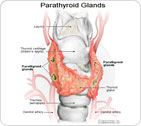Treatments for primary hyperparathyroidism
Traditional (outdated) surgery through a large incision
 The only true way to cure parathyroid disease is through surgical removal of the overactive parathyroid gland. Since 1925, this surgery has typically been done through a large 6-7 inch incision in the neck while the patient is under general anesthesia. After making the incision, the surgeon separates away the muscles of the neck and moves the thyroid gland aside to visualize the parathyroid glands. Based on visual inspection, the surgeon then goes in and removes the bad parathyroid gland and sutures the neck closed.
The only true way to cure parathyroid disease is through surgical removal of the overactive parathyroid gland. Since 1925, this surgery has typically been done through a large 6-7 inch incision in the neck while the patient is under general anesthesia. After making the incision, the surgeon separates away the muscles of the neck and moves the thyroid gland aside to visualize the parathyroid glands. Based on visual inspection, the surgeon then goes in and removes the bad parathyroid gland and sutures the neck closed.
As you can imagine, such a large surgery is not without its complications and requires an overnight stay in the hospital, sometimes even longer. Thankfully, this sort of large operation rarely needs to be performed anymore and in almost all cases can be replaced with minimally invasive surgery (MIS)
Newer Minimally Invasive Surgery (MIS)
One of the benefits of the ultrasound which was discussed earlier is the ability to identify exactly which parathyroid gland is bad. There is no need to make a 6 inch incision in the neck and explore all four parathyroid glands if you already know which one needs to be removed. In most cases, the bad gland is only about 0.5 inches in diameter, so why make a 6 inch hole to remove a 0.5 inch object?! Minimally invasive surgery allows the surgeon to go in through a tiny 1 inch incision to remove the bad gland. The patient generally does not require heavy general anesthesia like the larger operation, and can instead have very light sedation or anesthesia. Furthermore, the operation can be done in as little as 25 minutes, compared to more than 4 hours for the standard operation. When the operation is complete, the incision is closed with few stitches and a waterproof bandage and the patient is awake and alert within a few minutes.
Post-surgical recovery and Follow up
As we mentioned earlier, because minimally invasive surgery requires only light anesthesia, the vast majority of patients can go home 1-2 hours after the procedure. They are only required to take one day off of work – that is the day of the surgery. The patient can typically resume normal activities and return to work the day after the surgery without any restrictions.
Success Rates
The success rate of minimally invasive surgery approaches 100%, far higher than that of the standard operation. Furthermore, because the incision is so small and only one side of the neck is opened, risk of damage to nerves and surrounding structures is cut in half.
